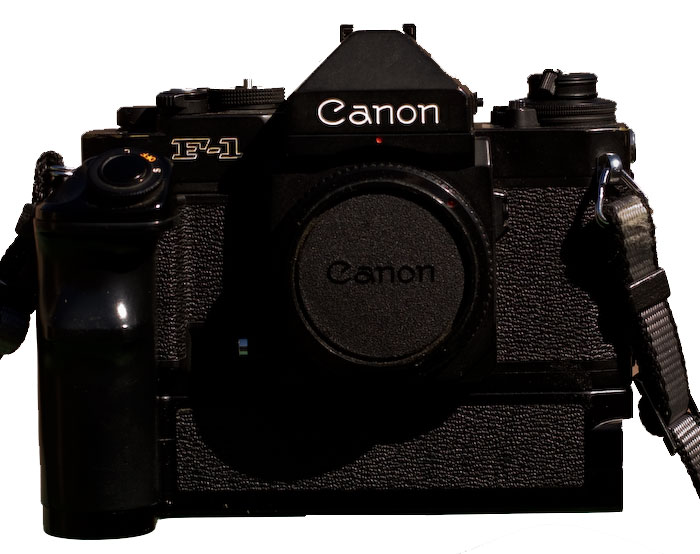
Lens Mount: FD bayonet/breech
Battery: PX625
Approx. dates of manufacture: 1981 - 1994
Approx. original price (body only): $450 (1981) - $650 (1991) - $1,100 (1994)
Approx. street value: high
There's an episode of the Mary Tyler Moore Show where Murray is falling asleep at work, making mistakes, etc. His wife thinks he's having an affair. Turns out he's moonlighting at a gas station to make extra money to buy his wife a new car. He's forced to quit the job before he can afford it, so he tells his wife (I have to paraphrase this), Murray: "remember the car you loved years ago when we first got married?" Wife: "you got me a new car?!" Murray: "no—I got you that car."
I feel like that with this camera. It came out in 1981, when I was seriously interested in photography and the new owner of an AE-1, so I was nostril-deep into cameras and Canon. I couldn't afford one then but drooled over it. It hasn't depreciated in value the way many other cameras have, so it's always been more money than I could justify just for a collection. It wasn't until now that I finally found one for a price I could accept. It was the last of my Most Wanted list.
If you want to read the whole F-1 backstory, please click that link. I don't want to cover that ground again.
The way I heard it, Canon was paranoid about losing their hard-won professional-photographer base, which was centered around the F-1. I read one account that the A-1 was supposed to be the successor, but Canon was afraid that pros would reject the electronics. So they made that an A-1 because it was the top of the A series and they developed a new camera that was updated, but closer to, the original F-1.
Another company might have called it the F-2 or G-1 or some other thing, but this is Canon and they decided to also call it the F-1; and at a glance (actually more than a glance), the new F-1 resembles the old F-1. In their literature, Canon called it the New F-1. Collectors like to call it the F-1N (upper-case N), as opposed to the Canon F-1n (lower-case n) which came out in 1974. I don't really care one way or the other, but I think the n/N distinction is easy for me to mis-read and mis-type, so I'm going to follow Canon's literature and call it the New F-1.
Canon wanted a camera that was going to be close enough to the original F-1 so old F-1 owners would feel comfortable with it; they wanted the features that pros liked, but they wanted to make it competitive in the age of electronic exposure controls. For the old owners, they kept the general look and feel—that was fairly easy. For the pros they gave it an electromagnetic shutter that still worked at speeds of 1/30th and higher if the battery failed, a top shutter speed of 1/2000th and 8 seconds max, and lots of accessories.
For exposure controls, they did something I never saw them do on any other camera: they added exposure modes via accessories. The base camera with the pentaprism (my camera has the base pentaprism) was all-manual. If you bought the winder or motor drive, it gave you Shutter Priority automation (you pick the shutter speed, the camera picks the aperture setting). If you bought the AE viewfinder, it gave you Aperture Priority automation (you pick the aperture, the camera picks the shutter setting). If you attached both, you got full automation.
Wikipedia says it went out of production in 1994. About that time Canon jacked the price of it way the hell up in order to kill it; just a few years before, the F-1 was about $650 and the EOS-1 was $1,000. Then they raised the F-1 to the same price as an EOS-1. Same camera, just an insane markup. Canon's incredible T90 was about half that.
Bought mine from an online auction; standard prism and the AE Power Winder FN. Now this may shock some people who haven't read some of my other camera pages, but this one came with leaky AA battery, which is currently stuck deep in the winder compartment. Duracell batteries come with use-by dates, and these said 2010 (I got it in 2018). The 6V lithium battery in the camera body, however, is still good.
I haven't been able to extract the bad battery yet. I'm trying to get it out without having to take the winder apart. The problem with taking these things apart is that they hide the screws under the leatherette, and they rarely ever look the same after they've been pealed off and glued back on (they tend to stretch out of shape).
Still, there's very little brassing and what little I tried (apart from the power winder) seems to work. Can't beat that with a stick.
But to anyone who reads this: take the batteries out of your cameras if you're not using actively using them.
For more information: Canon Camera Museum
Modern Photography magazine camera test: February 1982
One of Modern Photography magazine's Top Cameras
Camera manual: Orphan Cameras.com




.jpg)